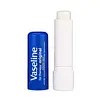What's inside
What's inside
 Key Ingredients
Key Ingredients

 Benefits
Benefits

 Concerns
Concerns

 Ingredients Side-by-side
Ingredients Side-by-side

Octyldodecanol
EmollientMicrocrystalline Wax
Emulsion StabilisingCaprylic/Capric Triglyceride
MaskingRicinus Communis Seed Oil
MaskingCetyl Palmitate
EmollientPetrolatum
EmollientMyristyl Myristate
EmollientPolyglyceryl-3 Distearate
EmulsifyingWater
Skin ConditioningButyrospermum Parkii Butter
Skin ConditioningCopernicia Cerifera Wax
Cetearyl Alcohol
EmollientC20-40 Alkyl Stearate
Skin ConditioningBeeswax
Emulsion StabilisingGlycerin
HumectantTocopheryl Acetate
AntioxidantPanthenol
Skin ConditioningOctyldodecanol, Microcrystalline Wax, Caprylic/Capric Triglyceride, Ricinus Communis Seed Oil, Cetyl Palmitate, Petrolatum, Myristyl Myristate, Polyglyceryl-3 Distearate, Water, Butyrospermum Parkii Butter, Copernicia Cerifera Wax, Cetearyl Alcohol, C20-40 Alkyl Stearate, Beeswax, Glycerin, Tocopheryl Acetate, Panthenol
Beeswax
Emulsion StabilisingDimethicone
EmollientPetrolatum
EmollientHydrogenated Polydecene
EmollientPhenyl Trimethicone
Skin ConditioningTrimethylpentanediol/Adipic Acid/Glycerin Crosspolymer
Skin ConditioningButyrospermum Parkii Butter
Skin ConditioningPrunus Amygdalus Dulcis Oil
Skin ConditioningHydrogenated Polyisobutene
EmollientMentha Piperita Oil
MaskingPolysilicone-11
Ethylene/Propylene/Styrene Copolymer
Sodium Saccharin
MaskingButylene/Ethylene/Styrene Copolymer
Pentaerythrityl Tetra-Di-T-Butyl Hydroxyhydrocinnamate
AntioxidantLimonene
PerfumingLinalool
PerfumingBeeswax, Dimethicone, Petrolatum, Hydrogenated Polydecene, Phenyl Trimethicone, Trimethylpentanediol/Adipic Acid/Glycerin Crosspolymer, Butyrospermum Parkii Butter, Prunus Amygdalus Dulcis Oil, Hydrogenated Polyisobutene, Mentha Piperita Oil, Polysilicone-11, Ethylene/Propylene/Styrene Copolymer, Sodium Saccharin, Butylene/Ethylene/Styrene Copolymer, Pentaerythrityl Tetra-Di-T-Butyl Hydroxyhydrocinnamate, Limonene, Linalool
 Reviews
Reviews

Ingredients Explained
These ingredients are found in both products.
Ingredients higher up in an ingredient list are typically present in a larger amount.
Beeswax is natural wax produced by honey bees and can be synthetically created. It consists mainly of fatty acid esters and long-chain alcohols.
In cosmetics, beeswax is a emollient. Due to its waxy structure, it creates a protective barrier. This barrier prevents water from evaporating off the skin.
This may not be a good ingredient for oily skin. We recommend speaking with a professional if you have concerns.
Beeswax cannot be removed with water, but can be taken off with an oil cleanser.
Beeswax is also antiseptic and contains vitamin A.
Learn more about BeeswaxThis ingredient is also known as shea butter. It is an effective skin hydrator and emollient.
Emollients help soothe and soften your skin. It does this by creating a protective film on your skin. This barrier helps trap moisture and keeps your skin hydrated. Emollients may be effective at treating dry or itchy skin.
Shea butter is rich in antioxidants. Antioxidants help fight free-radicals, or molecules that may harm the body. It is also full of fatty acids including stearic acid and linoleic acid. These acids help replenish the skin and keep skin moisturized.
While Shea Butter has an SPF rating of about 3-4, it is not a sunscreen replacement.
Shea butter may not be fungal acne safe. We recommend speaking with a professional if you have any concerns.
Learn more about Butyrospermum Parkii ButterPetrolatum is more commonly known as petroleum jelly. It is created by mixing waxes and mineral oils.
This ingredient is effective at reducing water loss by 99%. This is because it is an occlusive. Occlusives create a hydrophobic barrier on the skin to prevent evaporation. This property makes it great for hydrating dry skin.
Pro tip: Use occlusives, such as this ingredient, on damp skin for the best results.
The quality or origin of petrolatum is only known when disclosed by the brand. Most cosmetic petrolatum has gone through several purification stages.
Another benefit of occlusives is it protects your skin against infection or allergies.
Petrolatum may not be safe for fungal-acne. Studies show mineral oil / petroleum leads to the growth of M. Furfur, a type of yeast.
Learn more about Petrolatum